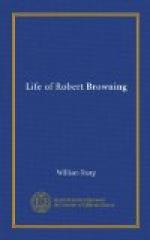It is altogether useless to urge, as so many admirers of Browning do, that “The Ring and the Book” is as full of beauties as the sea is of waves. Undeniably it is, having been written in the poet’s maturity. But, to keep to the simile, has this epical poem the unity of ocean? Does it consist of separate seas, or is it really one, as the wastes which wash from Arctic to Antarctic, through zones temperate and equatorial, are yet one and indivisible? If it have not this unity it is still a stupendous accomplishment, but it is not a work of art. And though art is but the handmaiden of genius, what student of Comparative Literature will deny that nothing has survived the ruining breath of Time—not any intellectual greatness nor any spiritual beauty, that is not clad in perfection, be it absolute or relative—for relative perfection there is, despite the apparent paradox.
The mere bulk of “The Ring and the Book” is, in point of art, nothing. One day, after the publication of this poem, Carlyle hailed the author with enthusiastic praise in which lurked damning irony: “What a wonderful fellow you are, Browning: you have written a whole series of ‘books’ about what could be summed up in a newspaper paragraph!” Here, Carlyle was at once right and wrong. The theme, looked at dispassionately, is unworthy of the monument in which it is entombed for eternity. But the poet looked upon the central incident as the inventive mechanician regards the tiny pivot remote amid the intricate maze of his machinery. Here, as elsewhere, Browning’s real subject is too often confounded with the accidents of the subject. His triumph is not that he has created so huge a literary monument, but rather that, notwithstanding its bulk, he has made it shapely and impressive. Stress has frequently been laid on the greatness of the achievement in the writing of twelve long poems in the exposition of one theme. Again, in point of art, what significance has this? None. There is no reason why it should not have been in nine or eleven parts; no reason why, having been demonstrated in twelve, it should not have been expanded through fifteen or twenty. Poetry ever looks askance at that gipsy-cousin of hers, “Tour-de-force.”
Of the twelve parts—occupying in all about twenty-one thousand lines—the most notable as poetry are those which deal with the plea of the implicated priest, Caponsacchi, with the meditation of the Pope, and with the pathetic utterance of Pompilia. It is not a dramatic poem in the sense that “Pippa Passes” is, for its ten Books (the first and twelfth are respectively introductory and appendical) are monologues. “The Ring and the Book,” in a word, consists, besides the two extraneous parts, of ten monodramas, which are as ten huge facets to a poetic Koh-i-Noor.




